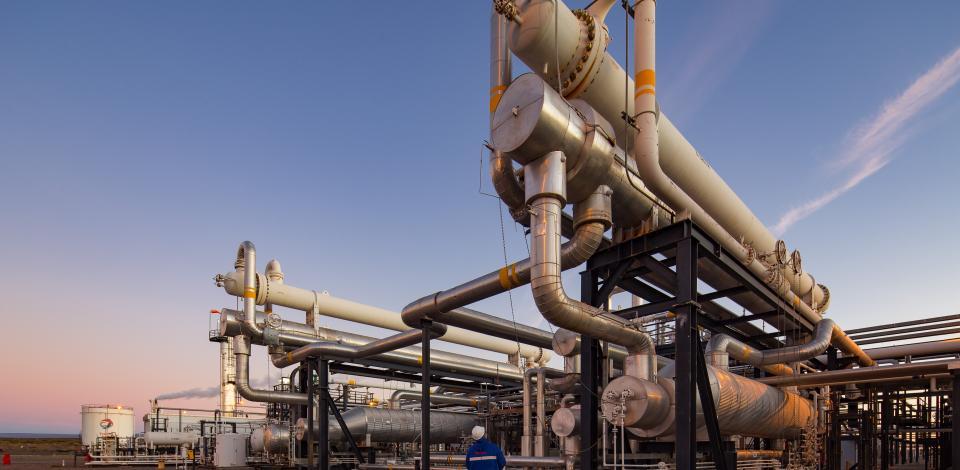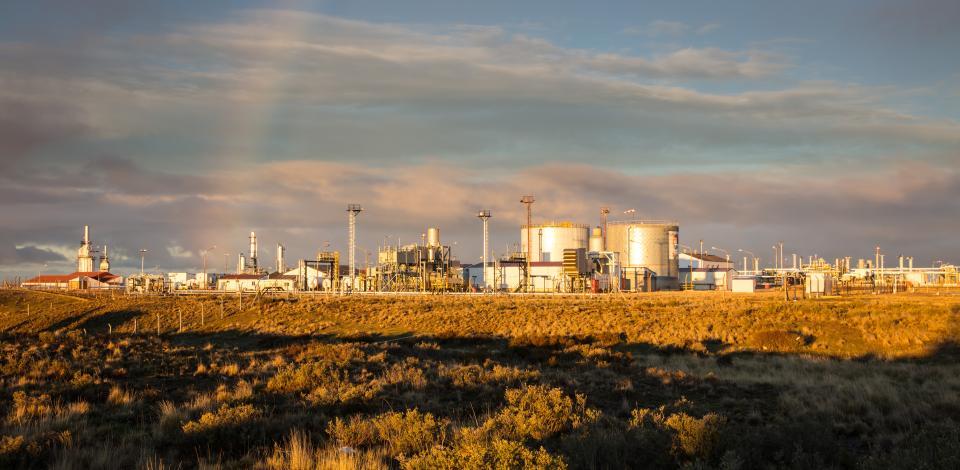Climate: Our path towards a world with more energies and less emissions
The ambition of TotalEnergies is to lead energy transition, supplying increasingly cleaner, more reliable and affordable energy to as many people as possible. Therefore, continuous improvement of our environmental performance is one of the key pillars of our corporate strategy.
As a major player of the energy industry, we have been working for many years to reduce the GHG emissions associated with our activities. At the same time, we have proactively joined diverse national and international bodies to identify joint solutions intended to restrict the increase of global temperatures to less than 2°C.
Our Environmental Responsibility
The more we learn about the environment, the more likely it is for us to anticipate potential risks and implement adequate preventive actions.
Before starting a project, at Total Austral we conduct an environmental impact assessment to define the initial situation and establish, in detail, the potential impacts from our future operations. At the same time, we plan a set of actions intended to mitigate such potential impact both during project execution and during site remediation, upon project completion.
On preparing the environmental impact assessment we hold conversations with different society agents, including communities and local authorities. Thanks to that scientific approach supporting our operations we can understand, prevent and respond to environmental risks applying the most stringent standards and the best energy industry practices.
A commitment translated into actions
Since 2010, TotalEnergies has actively worked on the reduction of GHG emissions and on improving energy efficiency at its facilities.
To get to net zero by 2050, together with society, TotalEnergies is transforming into a multi-energy company and deploying specific action plans to reduce its emissions and achieve its short- and medium-term objectives.
The Company is taking action to:
• Reduce emissions from its operated industrial facilities (Scope 1+2) by over 40% by 2030, compared to 2015 levels, and disclose the progress made at its operated and non-operated facilities.
• Reduce methane emissions by 80% by 2030, compared to 2020 levels.
• Reduce the indirect emissions related to its products (Scope 3), together with society – i.e., its customers, its suppliers, its partners, and public authorities – by helping to transform its customers’ energy demand.
- Scope 1: Direct emissions from our operated sites (eg: use of liquid and gaseous fuels, gas flaring, venting, fugitive emissions).
- Scope 2: Indirect emissions from consumption and distribution of energy (eg: purchase of electric energy from the grid).
- Scope 3: All indirect emissions not included in scope 2 occurring in the Company’s value chain, upstream and downstream (eg: transportation and use of marketed products, purchase of goods and services, transportation and trips of employees, waste treatment).
In line with this commitment, a work team was formed at Total Austral to develop a roadmap of projects for reduction of GHG emissions both in Neuquén and in Tierra del Fuego, classified in Level 1 and Level 2 Projects.
Level 1 Projects are low investment capital initiatives which may be rapidly implemented and which, in the aggregate, have a strong impact on carbon footprint reduction, to wit:
- Optimized use of MP A/B turbines (Tierra del Fuego). An optimization survey was conducted of our turbine operation philosophy which enabled us to stop a turbine at Cañadon Alfa Plant without affecting the gas potential and significantly reducing carbon emissions.
- Optimized electric generation at Río Cullen (Tierra del Fuego). After a detailed analysis, we challenged the generation concept, which enabled us to stop a turbine generator at Río Cullen and keep only one Gas Lift compressor in operation.
- Battery flare turn off (Tierra del Fuego & Neuquén). After a risk analysis and a detailed balance of Greenhouse Gas emissions, flares of Batteries 3, 4 and Alfa Sur in Tierra del Fuego and USP#3 in Neuquén were turned off, thus eliminating gas flaring and limiting venting to exceptional emergency cases.
- Stripping gas optimization (Tierra del Fuego). Thanks to a detailed operational analysis, and challenging operational philosophy, almost all stripping gas was reduced from the glycol units involved in the regeneration of MEG used for offshore gas production.
- Instrument Gas Replacement (Tierra del Fuego & Neuquén).
• Tierra del Fuego. Instrument gas was replaced by instrument air. For this project, an air pipeline network was built from the Cañadón Alfa plant reaching all batteries.
• Neuquén. 100% of the chemical injection skids were electrified and solarized, thus reducing methane emissions by 1kt per year. The replacement of instrument gas with compressed air at the San Roque and Aguada Pichana Este plants is under way. - Optimization of the use of turbine compressors (Neuquén). A study was conducted to optimize the operation of turbine compressors, which allowed us to reduce fuel gas consumption by adjusting suction pressures (Aguada Pichana Este) and avoid complete recirculation of the plant (San Roque), without affecting the gas potential and significantly reducing carbon emissions.
- Purchase of renewable energy for San Roque (Neuquén). Two agreements were entered into for the supply of wind and solar energy, which supply 80 to 100% of renewable energy.
- Improvement in flare combustion (Neuquén). Monitoring and adjustment chambers were installed to ensure flare ignition and to reduce methane emissions.
- Early shutdown of wellhead compressors (Neuquén). This initiative contributed to significantly reduce methane emissions.
- Improved availability of the Vapor Recovery Unit (VRU) at Rincón La Ceniza (Neuquén). The project improved compressor operation and reduced venting.
- Replacement of blanketing gas with Nitrogen (Neuquén). It consists of replacing the natural gas injected into the Aguada Pichana Este production water tank to generate a nitrogen inert atmosphere and avoid associated methane emissions.
Level 2 Projects include large-scale projects which demand significant survey, development and investment efforts in the medium and long term, to wit:
- Condensate Stabilization at Rincón La Ceniza (Neuquén). The installation of a very low- pressure compressor (LLP) to avoid tank venting associated with the increase of condensate production and reduce emissions during truck loading.
- A new high voltage line to operate the Aguada Pichana Este plant with renewable energy (Neuquén). A high voltage line connected to the Loma Campana Transformer Station is under construction, which will allow access to the Sistema Argentino de Interconexion (SADI). Thus, we will be able to replace fuel gas generators with renewable energy generators and have a low-emission platform to feed the Aguada Pichana Este plant.
- Compressor electrification (Neuquén). Replacement of Aguada Pichana Este gas compressors with integrated electric motor compressors, supplied by renewable energy, to reduce the main source of emissions: fuel gas.
- Operation in high pressure (HP) mode in Aguada Pichana Este (Neuquén). This project is intended to take advantage of Vaca Muerta wells pressure and operate in HP during the first years of production. This avoids gas compression and enables shutting down a turbine compressor, significantly reducing fuel gas consumption and associated emissions.
- Wind farm (Tierra del Fuego). Progress is being made in the project to install a wind farm that will generate renewable energy needed to feed the Río Cullen and Cañadón Alfa plants in Tierra del Fuego.
- Blanketing gas recovery at Río Cullen (Tierra del Fuego). The purpose of this development is the recovery, compression and re-injection of safety vent gases ("blanketing") from the Río Cullen oil export tanks.
- Elimination of blanketing gas at Cañadón Alfa (Tierra del Fuego). A change in the operating philosophy is under study to eliminate blanketing gas from the liquid tanks in batteries 1 and 2 at Cañadón Alfa and, consequently, to turn off flares.
- Recovery of Flared Gas (Tierra del Fuego & Neuquén). This is aimed at recovering safety gases in the flares of the Aguada Pichana (Neuquén), Río Cullen and Cañadón Alfa (Tierra del Fuego) plants, by means of a recovery, compression and reinjection system.
These Level 2 projects are currently at the feasibility analysis stage and have not yet been approved by the relevant consortia.
Actions and Certifications
To manage our environmental impact, improve our energy efficiency and reduce our emissions are key targets for TotalEnergies. For such reason we have developed the Environmental Management System (SGA, by its acronym in Spanish), which provides the framework for the continuous improvement of our environmental performance. It is made up of a manual and seven general procedures which comprise each of the requirements to comply with the ISO 14001:2015 Standard. This international standard controls, audits and helps improve the environmental management operations of companies.
Thus, our SGA allows us to establish annual targets, taking into account legal requirements and environmental aspects and impacts derived from our activities to be able to be ISO 14001:2015 certified at all sites at which we operate.
As of today, all Total Austral sites are ISO 14001:2015 certified.
- Buenos Aires (see certificate)
- Neuquén (see certificate)
- Aguada Pichana
- San Roque
- Rincón la Ceniza
- City of Neuquén Offices
- Tierra del Fuego (see certificate)
- Río Cullen and offshore activities (Hidra Norte, Hidra Centro, Carina, Aries and Vega Pléyade Rigs)
- Cañadón Alfa
- Río Grande Offices
- Punta Quilla Logistic Base (Province of Santa Cruz)
In turn, TotalEnergies Marketing Argentina has the following certifications:
- Environmental Management System: ISO 14001:2015 (certification obtained for the production of lubricants)
- Quality Management System: ISO 9001:2016 (certification obtained for the production of lubricants, sales and technical support) and IATF 16949 (certification obtained for the production of lubricants for the factory fill of automobiles, sales and technical support).
Current and Future Commitment
Environmental care is our main concern to develop a sustainable activity that can be maintained through time. In this regard, while specific objectives may vary from year to year, our final goal remains the same: to respect the environment and minimize environmental impact in each of the activities we carry out. It is TotalEnergies’ commitment to know, preserve and protect environmental biodiversity at those places where it carries out its activities. Total Austral conducts specific surveys in this regard and drafts biodiversity management plans aimed at the harmonious development of operations, especially protecting those species that are most sensitive or in risk according to their international classification (IUCN).
We consider that it is critical to foster an environmental culture shared by all of us at TotalEnergies Argentina. Therefore, on a daily basis we devote all our efforts to implement initiatives that lead us to continue consolidating as a pioneer company in the respect for the environment.
Related Documents
- Health, Safety and Envionrmental Policy (click here)




